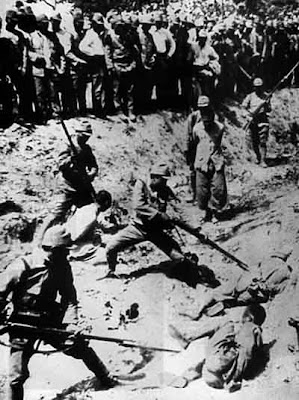Sook Ching Massacres



The Sook Ching massacre (Chinese: 肅清大屠殺) was a systematic extermination of perceived hostile elements among the Chinese in Singapore by the Japanese military during the Japanese Occupation of Singapore, after the British colony surrendered in the Battle of Singapore on 15 February 1942 during World War II. Sook Ching was later extended to include Chinese Malayans. The massacre took place from February 18 to March 4 1942 at various places.
The term Sook Ching (肅清) is a Chinese word meaning "a purge through cleansing". At the time, the Japanese also described the massacre as such (it was referred to as the Kakyōshukusei (華僑粛清), or "purging of Chinese"). The Japanese also referred to it as the Shingapōru Daikenshō (シンガポール大検証), lit. "great inspection of Singapore".
Although the term "Sook Ching" appeared as early as 1946, it was not commonly used in the Chinese press or other publications until the 1980s. It is not clear whether it was the Japanese or Chinese who first used Sook Ching/shukusei, which is 粛清 in both languages.
Yamashita instructed the Syonan garrison to cooperate with the Syonan Kempeitai, the Japanese military police, and carry out "severe punishment of hostile Chinese."
Soon after the fall of Singapore, Lieutenant Colonel Masayuki Oishi, commander of No. 2 Field Kempeitai, set up his headquarters at the YMCA Building in Stamford Road, which also served as the Kempeitai East District Branch. The Kempeitai jail was in Outram with branches in Stamford Road, Chinatown, the Central Police Station. A residence at the intersection of Smith Street and New Bridge Road formed the Kempeitai West District Branch. Under Colonel Oishi were 200 regular Kempeitai officers and another 1,000 auxiliaries who were mostly young, rough peasant soldiers. Singapore was broken up into sectors, each placed under the control of a Kempeitai officer. The Japanese set up designated "screening centres" all over the colony to gather and screen all Chinese males between 18 to 50 years old, eliminating those thought to be anti-Japanese. Sometimes, women and children were sent for inspection. In reality, the screening was arbitrary and non-selective, and could involve as little as walking past a Japanese officer. Most of those identified were innocent people and were just killed brutally without reason.
The ones who passed the "screening" would receive a piece of paper with "Examined" written on it, or have a square ink mark on their arms and shirts. Those who did not pass the "screening" would be stamped with triangular marks. There were trucks near these screening centers to send those who failed to their deaths. The Japanese Army chose remote sites such as Changi, Punggol, Blakang Mati and Bedok to perform the executions, with the victims thrown overboard off boats, killed with a bayonet or be machine-gunned to death off the harbour.
At the behest of Lieutenant Colonel Tsuji Masanobu, who had played a key role in the organisation of the Singapore operation, Sook Ching was extended to the rest of Malaya, particularly Penang. However, in these rural areas the Japanese did not have the luxury of working with a concentrated population, so the army did not have sufficient time nor manpower to fully interrogate the entire Chinese population. Therefore, widespread indiscriminate killing of the Chinese population occurred, even though the Japanese made a show of screening the civilians and identifying the guerrillas.
After the Japanese military realized that they could not kill off as many as 50,000 Chinese, and that Japan's resources were being stretched with advances in other parts ofSoutheast Asia, the head of the authorities called off the killing on 3 March.
The Sook Ching Massacre cost the Japanese military administrators any chance of cooperation with local Singaporeans, especially the Chinese community. Unlike many other places in Southeast Asia Japan occupied during the war, Singaporeans did not view the Japanese army as liberators of European imperialism in Asia. Even though Singapore did not have a nationalist movement like other places in Asia because of the diverse demographics, the Japanese army was unable to exploit ethnic differences to their advantage.


Comments
Post a Comment